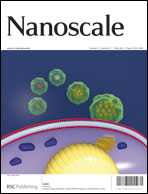Atomistic simulations of highly conductive molecular transport junctions under realistic conditions†
Abstract
We report state-of-the-art atomistic simulations combined with high-fidelity conductance calculations to probe structure–conductance relationships in Au–benzenedithiolate (BDT)–Au junctions under elongation. Our results demonstrate that large increases in conductance are associated with the formation of monatomic chains (MACs) of Au atoms directly connected to BDT. An analysis of the electronic structure of the simulated junctions reveals that enhancement in the s-like states in Au MACs causes the increases in conductance. Other structures also result in increased conductance but are too short-lived to be detected in experiment, while MACs remain stable for long simulation times. Examinations of thermally evolved junctions with and without MACs show negligible overlap between conductance histograms, indicating that the increase in conductance is related to this unique structural change and not thermal fluctuation. These results, which provide an excellent explanation for a recently observed anomalous experimental result [Bruot et al., Nat. Nanotechnol., 2012, 7, 35–40], should aid in the development of mechanically responsive molecular electronic devices.


 Please wait while we load your content...
Please wait while we load your content...